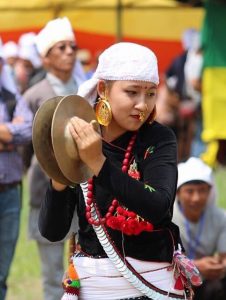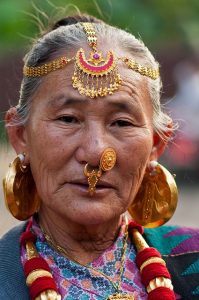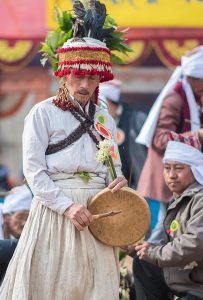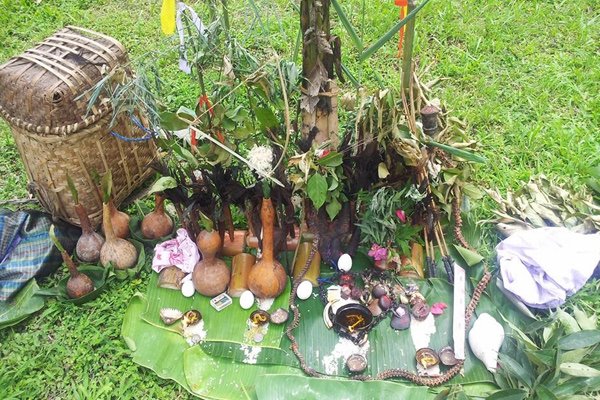
Rai is one of the important ethnic groups of Kirati people. Rais are also well known as Gurkha army in Indian and British Army. Their bravery has made them famous around the world. Rais are also known as honest people with a great courage.
Traditionally Rai resided from lower regions of Dudh Koshi (दुध कोशी) to the regions of Arun River. This region is called Khambuan or Majh Kirat. Therefore Rais are also sometimes referred as Khambu. The main districts in Majh Kirat are Solukhumbu, Sangkhwasava, Okhaldhunga, Khotang, Bhojpur and Udayapur. This region lies on the altitude of 3,000 to 6,000 meters above the sea level.
We cannot certainly say the exact migration routes of Rai people, but one plausible history is Kirati migrated from Tibet and few from Indian region in Kathmandu valley. Then it is believed they slowly migrated to eastern part of Nepal. For this reason, out of 10 main castes in Rai, three (3) are Lhasa gotra (ल्हासा गोत्र ) and seven (7) are Kashi gotra (काशी गोत्र). Today there are more than 32 castes of Rai ethnicity. They also have more than 28 different dialects that are still in practice in Rai communities.






Generally, Rai houses are simple but beautiful two story building made of mud and bricks similar to other traditional village houses of Nepal. The upper story usually has veranda and they have a wooden step called Aaglo (आग्लो) to climb up. Agriculture were Rai’s main occupation. They grew maize, millet, wheat, rice, and mustard seeds. Their staple foods are dal, bhat, tihun (तिहुन), khole (खोले), dhindo etc. Rai people are expert in cooking pork (सुंगूर or बंगुर). One of the main roles of grains in Rai people is to make jaad जाड (millet beer) or rakshi रक्सि (spirit).
Rais have mastered in making millet beer over generation. There are few unique cuisines that is distinct in Rai culture. For example, Kinima – boiled fermented soybean, Wachipa – burnt feather end remaining from skin of chicken fried with rice. They make lentil (तिहुन) of Kinima, whereas Wachipa is consumed as snacks (सितन) with Jaad. If you ever get a chance Kinima is a must try. This dish will explode your mouth with flavors. स्वाद मुखमा नै झुन्डिने छ ।
Rai people have a unique traditions and costumes as well. Women Rais typically wear Chaubandi Cholo (blouse or top) and Fariya (saree) with Patuki on their waist. While Rai men were Daura Surwal with ashcoat with Patuki on the waist with Khukuri. Similarly, women were ornaments such as Muga Mala, Reji Haari mala, Chaadi ko Kangan, Authi, Naakma Phuli ra Jhamke Bulaki, Dhungri etc.

Rai culture as Kirati in general gives a big importance to nature as their god. Bhumi puja (earth praying) or henkama is something they practice religiously. Also, remembering ancestors’ souls are important part of their rituals. Their home has one corner dedicated to ancestors called machakuma (पितृ थान). Twice a year during Udhauli and Ubhauli, Rai perform special rituals offering Hen neat, Rakshi (spirit), Acheeta (grains), Ginger (aduwa) etc to ancestors’ soul (Pitri) remembering them for their blessings.
Rai people have many fascinating culture and traditions that we all need to be aware of while Rai people need to preserve their heritage by uniting each other and promoting their rituals. Please comment on this blog if you have additional interesting facts that would make this blog richer and interesting.







Thank you for your special note on Rai community, one of my favorite ethnic groups of Nepal. You have briefly mentioned about their 32 castes and 28 different dialects; I would greatly appreciate if you would elaborate more on these two topics. I am keenly interested to learn more about Rai Community, their food etc.
Thank you.
Regards,
Anil
Thank you Anil for your comment and further request. We will provide you the details to your query soon.